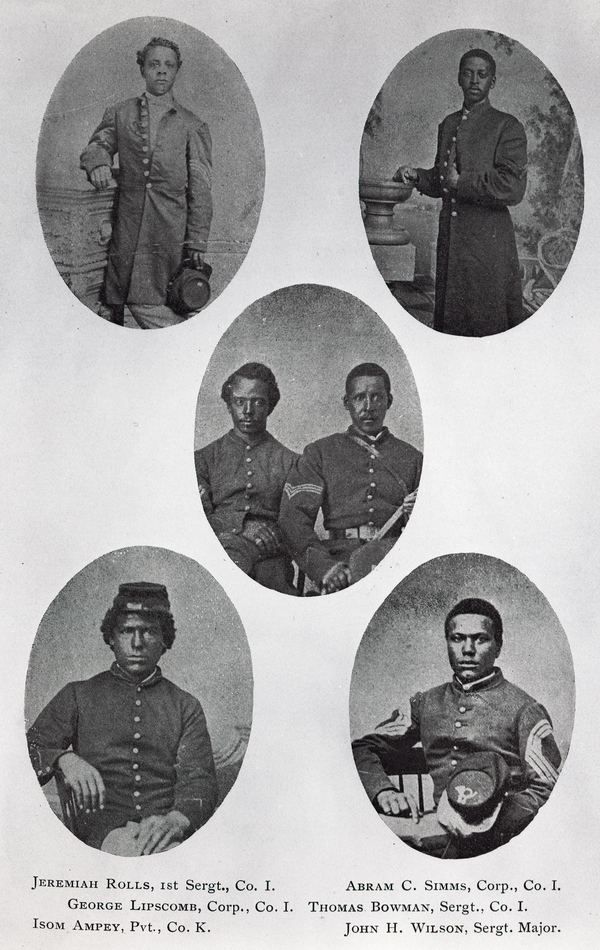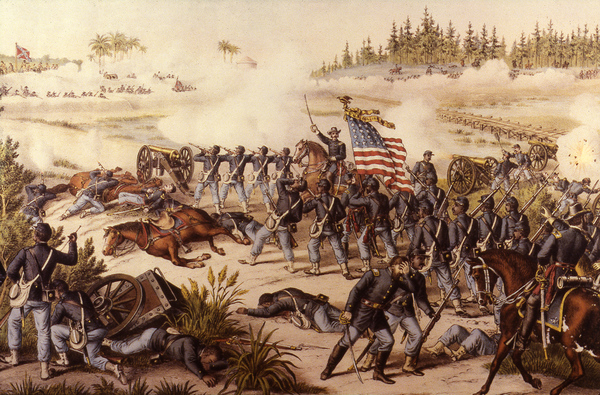Description of previous item
Description of next item
Battle of Olustee (February 20, 1864)
Published February 2, 2014 by Florida Memory
In commemoration of Black History Month, this series of blog posts highlights African-American history in Florida.
In February 1864, the Union launched what would be the war’s largest military campaign in Florida. Designed to interrupt the supply of cattle and goods from the state that were destined for Confederate armies outside of Florida, add more escaped and freed slaves to the ranks of the U.S. Army, and possibly bring Florida back into the Union as a reconstructed free state, the northeast Florida campaign of 1864 consisted of some 7,000 Union troops, including three black regiments: the 1st North Carolina Colored Infantry, the 8th U.S. Colored Infantry (USCT), and the 54th Massachusetts Volunteer Infantry.
The 54th had already distinguished itself on the ramparts of South Carolina’s Fort Wagner during the unit’s now famous assault on that Confederate bastion in July 1863. Unlike the 54th, however, the two other regiments had never been in combat, and the 8th USCT had not even completed its training when it arrived in Florida along with the rest of the Union troops on February 7, 1864.
Leaving about 1,500 men to secure Jacksonville and conduct other missions, the main Union force of 5,500 troops under the command of Brigadier General Truman Seymour began marching on February 20 west towards Lake City and the Suwannee River beyond. East of Lake City the Federals ran into advanced elements of a Confederate force of 5,000 men that established defensive positions outside of Lake City at Olustee, a station along the Florida, Atlantic & Gulf Railroad. The battle, which lasted through the afternoon of February 20, was a particularly bloody encounter that ended in a Confederate victory and a humiliating Union retreat back to Jacksonville.
The more experienced 54th Massachusetts as well as the 1st North Carolina played an important role in the battle by holding back the Confederate advance as the rest of Seymour’s regiments withdrew. One of those regiments, the 8th USCT, experienced some of the day’s heaviest fighting. Its untested ranks were ordered forward and ran into a storm of Confederate fire.
At the end of the battle, the 8th USCT lost more men than any other Union unit: 49 killed, 188 wounded, and 73 missing. Of these missing, several became prisoners and were eventually transferred to the infamous Confederate prisoner of war camp at Andersonville, Georgia. Others may have faced an even worse fate. Several postwar accounts, mostly from Confederate sources, recalled that individual Confederate soldiers killed some of the wounded and captured black soldiers.
After Olustee, black troops continued to play an important role in Union operations in Florida. In September 1864, they made up part of the force that attacked Marianna, Florida, and on March 6, 1865, black soldiers formed the mass of the Union troops that engaged the Confederates south of Tallahassee at Natural Bridge. The Union lost the battle and was denied the opportunity to capture Tallahassee during the war. A little over two months later, however, black troops marched into Florida’s capital as part of the Union occupying force that received the formal surrender of Confederate Florida on May 20, 1865.
Today, while the operations of black troops are better known in theaters of the war such as South Carolina (the assault on Fort Wagner on July 18, 1863) and Virginia (the Battle of the Crater on July 30, 1864), the actions of black troops in Florida, although less famous, were just as crucial to establishing the importance of black units in the Union war effort. Although the direct path to Union victory and black freedom pointed to Atlanta and Richmond, the route included many detours, like Florida, which ultimately led to emancipation.
Cite This Article
Chicago Manual of Style
(17th Edition)Florida Memory. "Battle of Olustee (February 20, 1864)." Floridiana, 2014. https://www.floridamemory.com/items/show/295149.
MLA
(9th Edition)Florida Memory. "Battle of Olustee (February 20, 1864)." Floridiana, 2014, https://www.floridamemory.com/items/show/295149. Accessed December 5, 2025.
APA
(7th Edition)Florida Memory. (2014, February 2). Battle of Olustee (February 20, 1864). Floridiana. Retrieved from https://www.floridamemory.com/items/show/295149

 Listen: The Assorted Selections Program
Listen: The Assorted Selections Program
